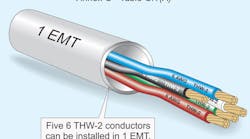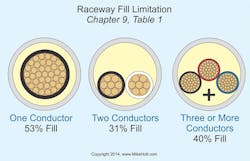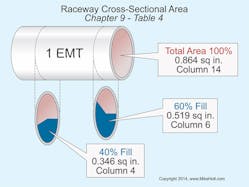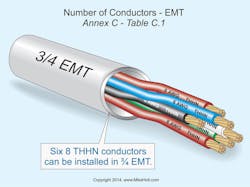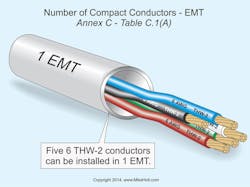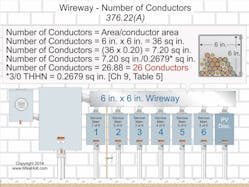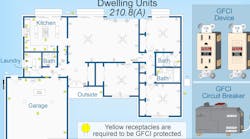If raceway is too small, you can damage conductors while trying to pull them through. Even if they aren’t damaged during the pull, they may overheat inside an undersized raceway. For these reasons, the NEC has requirements for minimum raceway size.
You can size a raceway with this three-step method:
Step 1: Determine the cross-sectional area (in square inches) for each conductor from Chapter 9, Table 5 for insulated conductors and from Chapter 9, Table 8 for bare conductors.
Step 2: Determine the total cross-sectional area for all conductors.
Step 3: Size the raceway according to the percent fill as listed in Chapter 9,
Table 1 (Fig. 1).
Chapter 9, Table 4 includes the various types of raceway. Columns represent the allowable percentage fills, such as 40% for three or more conductors, and 60% for raceways 24 in. or less in length (Fig. 2). Be careful when selecting a raceway from Chapter 9, Table 4; this table is divided up into numerous tables for each raceway type, and you must choose the correct section of the table for the type of raceway for which you’re performing the calculations.
What size does a raceway need to be for a given number of conductors, or how many conductors can you pull into a raceway of a given size? You can determine the answer using the tables in Annex C. The catch is that all conductors in a conduit or tubing must be the same size (total cross-sectional area including insulation). And, of course, you need to use the table that addresses your particular conductors and raceway. For example, Table C.1 is for conductors and fixture wires in electrical metallic tubing (EMT), while Table C.2 is for compact conductors in EMT.
For situations where conductors of different sizes are in a raceway, Chapter 9 contains the information necessary to calculate the required raceway size. Because different conductor types (e.g., THW, TW, and THHN) have different thicknesses of insulation, the number and size of conductors permitted in a given raceway often depends on the conductor type used.
What happens if you change several variables? Compare these two sample problems:
Problem No. 1
Question: How many 8 AWG THHN conductors can be installed in trade size ¾ EMT?
The answer is 6 conductors [Annex C, Table C.1] (Fig. 3).
Problem No. 2
Question: How many 14 AWG RHH conductors (with cover) can be installed in trade size 1 EMT?
The answer is 11 conductors [Annex C, Table C.1].
Note 2 at the end of Annex C, Table C.1 indicates that an asterisk (*) with conductor insulation types RHH*, RHW*, and RHW-2* means that these types don’t have an outer covering. Insulation types RHH, RHW, and RHW-2 (without the asterisk) do have an outer cover. This is a cover (which may be a fibrous material) that increases the dimensions of the conductor more than the thin nylon cover encountered with conductors such as THHN.
If you decrease the conductor size and/or increase the raceway size, you can run more conductors in that raceway. In this case, we did both and could run nearly twice the number of conductors in the raceway.
Using the table to run some quick “what if” comparisons can help you optimize your raceway design.
Now, compare these two problems:
Problem No. 1
Compact Conductors in EMT
Question: How many 6 AWG THW-2 compact conductors can be installed in trade size 1 EMT?
The answer is five conductors [Annex C, Table C.1(A)] (Fig. 4).
Problem No. 2
Question: How many 6 AWG XHHW conductors can be installed in trade size 1 ENT?
The answer is five conductors [Annex C, Table C.2].
We’ve changed the type of conductor and the type of raceway, but not the size of raceway. We get the same number of conductors, but what if you changed the 6 AWG conductor in the second example to TFE? Then you’d be able to run seven conductors. Change to THW-2, and it’s only three. But change the raceway to IMC and you can run five.
Sizing wireways
A wireway is defined as a sheet metal raceway with hinged or removable covers for housing and protecting electric conductors and cable, and in which conductors are placed after the raceway has been installed [376.2].
Wireways are commonly used where access to the conductors within the raceway is required to make terminations, splices, or taps to several devices at one location. Their high cost precludes their use for long distances, except in some commercial or industrial occupancies where the wiring is frequently revised.
The maximum size conductor permitted in a wireway must not be larger than that for which the wireway is designed [376.21].
Splices and taps can’t fill more than 75% of the wiring space at any cross section [376.56]. Where conductors are bent within a metal wireway, size the wireway to meet the bending radius requirements contained in Table 312.6(A), based on one wire per terminal [376.23(A)].
The maximum number of conductors permitted in a wireway is the number that will fill 20% of the cross-sectional area of the wireway [376.22(A)].
The next few examples will help you understand the interplay between common variables in wireway sizing.
Question: What’s the cross-sectional area of a 6 in. × 6 in. wireway?
To calculate the cross-sectional area of the wireway, simply multiply height by depth: 6 in. × 6 in. = 36 sq in.
Question: What’s the maximum allowable conductor fill in square inches for a 6 in. × 6 in. wireway?
— Wireway Area = 6 in. × 6 in. = 36 sq in.
— Wireway Conductor Fill = 36 sq in. × 0.20 = 7.20 sq in. [376.22(A)]
Question: What’s the maximum number of 3/0 THHN conductors you can install in a 6 in. × 6 in. wireway (Fig. 5)?
— Wireway Area = 6 in. × 6 in. = 36 sq in.
— Wireway Conductor Fill = 36 sq in. × 0.20 = 7.20 sq in. [376.22(A)]
— Area of 3/0 THHN = 0.2679 sq in. [Chapter 9, Table 5]
— Number 3/0 THHN Conductors in Wireway = 7.20 sq in. ÷ 0.2679 sq in. = 26
Note: The 0.80 or larger rounding up rule of Chapter 9, Table 1 Note (7) applies only to conduit or tubing.
Question: What’s the maximum number of 500 kcmil THHN conductors you can install in a 6 in. × 6 in. wireway? — Wireway Area = 6 in. × 6 in. = 36 sq in.
— Wireway Conductor Fill = 36 sq in. × 0.20 = 7.20 sq in. [376.22(A)]
— Area of 500 kcmil THHN = 0.7073 sq in. [Chapter 9, Table 5]
— Number 500 kcmil Conductors in Wireway = 7.20 sq in. ÷ 0.7073 sq in. = 10
A final lap around the raceway
Seemingly small decisions in such things as conductor type or raceway type can have a major effect upon how many raceways you must run and how large they must be. In a given project, you might think choosing a lower-cost conductor reduces project costs. But if using that conductor means running two additional raceways, with their fittings, bends, and supports, you’ve probably got a much higher project cost.
And that assumes there’s even sufficient space for the additional raceways. A given situation might call for the most space-efficient installation rather than the lowest cost one or meeting some mix of the two goals.
This issue gets complicated by the fact that all of the conductors for a given circuit must run in the same raceway. Performing some comparative sizing calculations using different conductor types and/or raceway types can help you see the most cost-effective way to proceed — but only if you remember to group the conductors by circuit.
For example, suppose you’re running several 480V circuits. Each of these has three phases, thus three current-carrying conductors per circuit. If a given raceway can hold a maximum of eight of these conductors, you’re going to fill it with only six. If you need to run three circuits, that means two raceways unless you change the conductor type, raceway type, or raceway size.
Holt is the owner of Mike Holt Enterprises, Inc. in Leesburg, Fla. He can be reached at www.mikeholt.com.
